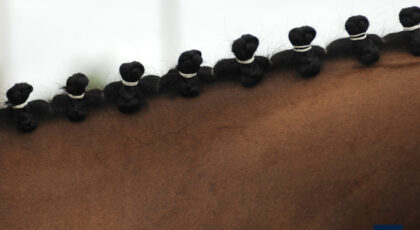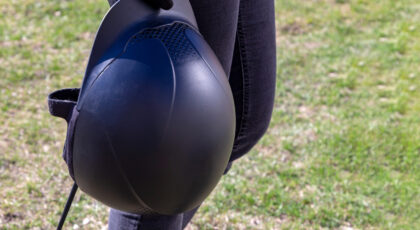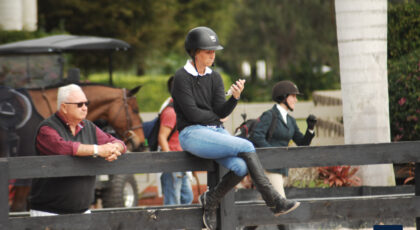For ten years, I did Pilates, loving the flexibility and tone and core strength I gained in an hour-long class that, for me, was the equivalent of meditation. Breathing, isolated movement—I loved how I left the room feeling taller, more relaxed, and like all my aging hinges had been greased.
How cool is it, then, that the same principles that help our bodies in the Pilates studio can help our horses in the ring? Pilates teacher (for humans!) and eventer Laura Reiman has developed a collection of exercises that she says can help to build and maintain a solid foundation of strength and comfort in your horse, increasing balance, mobility, and stability. In this excerpt from her book, Pilates for Horses, she shows how using ground poles on a bend is an easy way to incorporate therapeutic exercise into your training routine.
*****
WHAT
Ask your horse to work over lifted ground poles or cavalletti on the longe line. Higher poles make the horse bend his joints more, creating more mobility through the body. Poles can be lifted on alternating ends, lifted just on the inside or just on the outside, or lifted on both ends.
WHY
- Poles with the inner ends raised: increases flexion of the inside hind leg and retraction of the inside shoulder, encourages bend, helps balance the front end, and increases scapula glide. This exercise is helpful for horses that fall in.
- Poles with the outer ends raised: mobilizes the scapula, engages the latissimus dorsi on the outside of the body, helps balance the front end, engages the oblique stabilizing muscles, and encourages lift/flexion/activity in the outside hind limb.
- Poles with alternating ends raised: increases proprioception and balance, engages the abdominals, and loosens the back.
- Poles with both ends raised: the higher the pole, the more the horse must bend his joints and spring up while maintaining an even tempo.
- Raised ground poles help to de-weight the front end and transfer that weight to the hind, creating a lighter forehand, swinging back, and improved hind-end strength and pelvic stability.
- Horses learn to balance themselves and gain confidence over raised poles. This is an excellent exercise for one-sided stiffness and identifying weak pelvic muscles.

HOW
1 Place 3-6 poles flat on the ground in a fan shape on a half-circle, roughly 3 feet apart for walking, 4-4½ feet apart for trot work, or 9-12 feet apart for canter work. You can also set up two circles of ground poles with different spacing on either side of your warm-up area in a Venn diagram shape in order to easily work between two gaits.
2 Start by warming the horse up at the walk and trot on a 20-meter circle, 5-10 minutes in each direction, near the poles but not over them.
3 After warming up, move the longe circle over and aim the horse toward the center of the ground poles, asking for an active and even walk, trot, or canter.
4 Once the horse has worked over the poles several times, raise them on the desired side (inside, outside, alternating ends, or both ends) and repeat.
5 Make sure the horse doesn’t drift toward the lower side of the poles and maintains a forward rhythm.
6 Start with the easier direction for your horse, but make sure to work both directions. Changing direction often is a good way to give your horse much-needed breaks during the work.
7 Work over poles 4-6 times before reversing, and repeat 3-5 times.
8 If you’ve set up two circles, switch between them before reversing. Allow the horse to rest for several circles away from the poles before repeating.
TIPS FOR SUCCESS
- Encourage a long-and-low headset, consistent tempo, and slight inside bend.
- Maintain steady contact with the longe line.
- Start with fewer poles and add more to increase difficulty.
- You can play with different formations of your ground poles, but try to keep spacing in the center of the poles consistent.
- Keep this workout short and sweet so your horse doesn’t become lazy over the poles. Switch between poles and flatwork often, and change direction multiple times.
COMMON ISSUES & PRECAUTIONS
- Keep poles around or below 6 inches high to discourage jumping over them.
- Aim for the middles of the poles. Don’t be afraid to stop and adjust the spacing if needed in order to make the horse successful. Smaller strides target the flexor muscles while larger strides target the extensor muscles.
- If the horse is lacking strength or balance, try using 2-3 poles in a straight line instead of on a curve, and allow them to navigate the poles while going straight, turning before and after the poles to complete the longe circle. You can also stop and hand-walk the horse over raised walk poles.
This excerpt from Pilates for Horses by Laura Reiman is reprinted with permission from Trafalgar Square Books (www.HorseandRiderBooks.com).


 June 29, 2021
June 29, 2021 

























